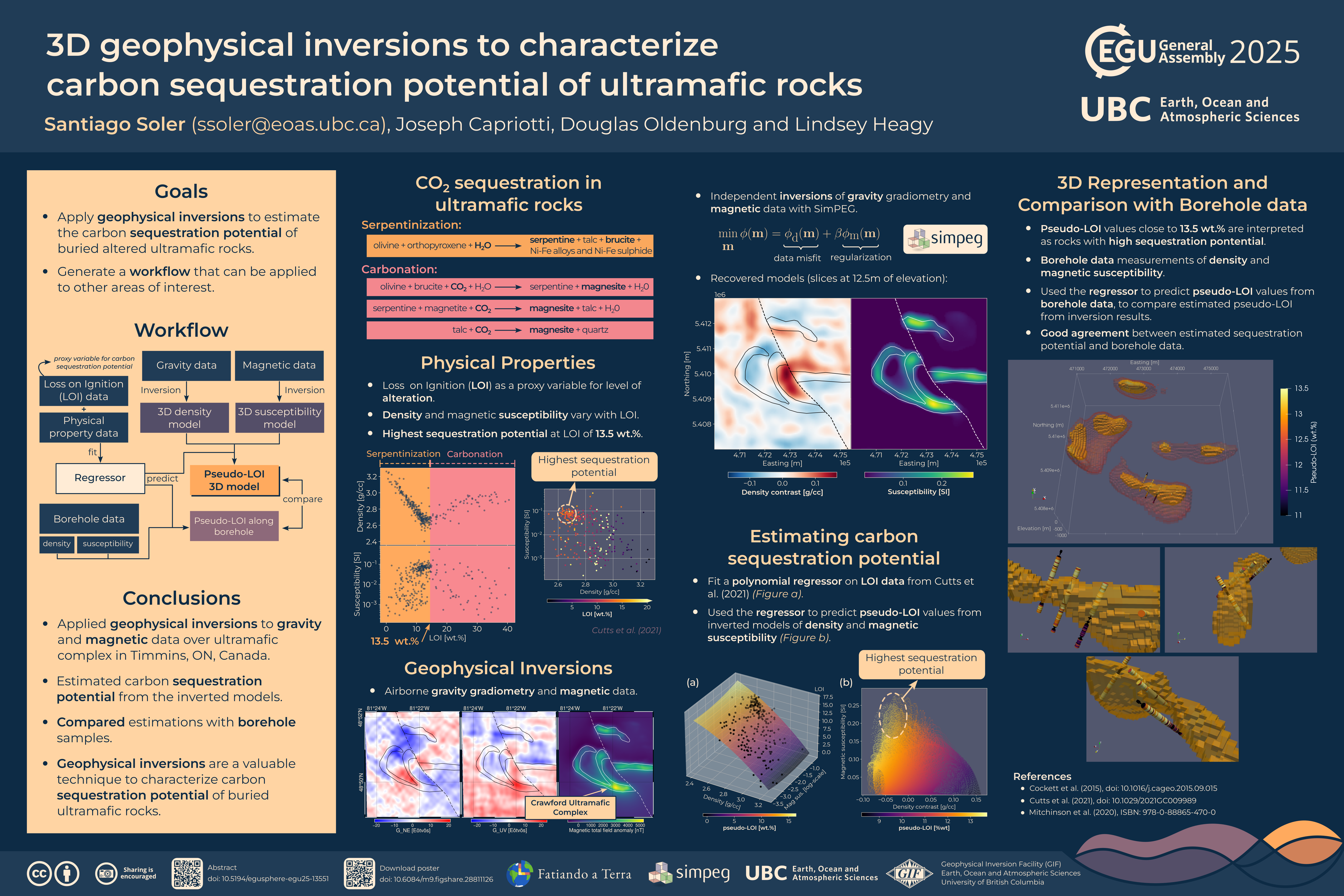3D geophysical inversions to characterize carbon sequestration potential of ultramafic rocks
Info
- Presented at: EGU General Assembly 2025
- Source code: santisoler/egu2025
- Creative Commons Attribution 4.0 International
- doi: 10.5194/egusphere-egu25-13551
Poster
The poster has been archived in figshare under the following doi: 10.6084/m9.figshare.28811126.
Find the poster in other file formats in santisoler/egu2025.
Abstract
Carbon mineralization in ultramafic rocks has been proven to be one of the ways of sequestering CO2 from the atmosphere to mitigate climate change effects and limit global temperature increases to values compatible with life on Earth as we know it. The sequestration of CO2 in ultramafic rocks takes place during reactions between minerals rich in Mg, like brucite and serpentine, and CO2-bearing fluids. The results of these reactions are carbonate minerals that trap the CO2 in a geologically and chemically stable form. Such Mg-rich minerals are present in higher concentrations in ultramafic rocks that have undergone serpentinization. Serpentinized rocks tend to have higher concentrations of these Mg-rich minerals as compared to the unaltered and carbonated ones. This means that serpentinized rocks have greater sequestration potential than their unaltered and carbonated counterparts.
The physical properties of ultramafic rocks undergo measurable changes during serpentinization and carbonation reactions. Serpentinized ultramafic rocks have a lower density and tend to have higher magnetic susceptibility than their unaltered and carbonated counterparts. These changes in their physical properties open the opportunity to apply geophysical techniques to map the spatial distribution of serpentinized rocks and estimate their sequestration potential.
We applied 3D geophysical inversion on airborne gravity gradiometry and magnetic data over the Crawford Nickel Sulphide Project (north of Timmins, Ontario, Canada) to obtain 3D models of the density and magnetic susceptibility distributions of the subsurface. We integrated these recovered models to estimate the carbon sequestration potential of the rocks.
We applied independent Tikhonov inversions to both the gravity gradiometry and magnetic datasets along with a joint Petrophysically-Guided Inversions (PGI). We trained a regression model to predict spatial distributions of Loss of Ignition (LOI) values in the subsurface from the inverted results of density and magnetic susceptibility. The LOI works as a proxy variable for alteration levels: unaltered ultramafic rocks have low LOI values (<5%), followed by serpentinized rocks with high sequestration potential (between 10% and 13%), and carbonated rocks with even greater LOI values (>14%). The estimated LOI values obtained after the inverted 3D models can be used as a metric to infer the alteration levels of the rocks and their location in the subsurface.
The recovered 3D model of LOI is in good agreement with LOI estimations obtained from physical property observations carried out in borehole samples. These results show that 3D inversions of gravity gradiometry and magnetic data are a viable technique to characterize the sequestration potential and the spatial distribution of ultramafic rocks in the subsurface. Geophysical data acquisition and 3D inversions can be used as a meaningful source of knowledge that can complement the geologic exploration, drilling planning phases, and decision-making for carbon sequestration feasibility in a given area.
